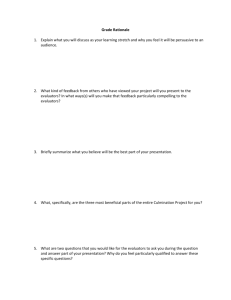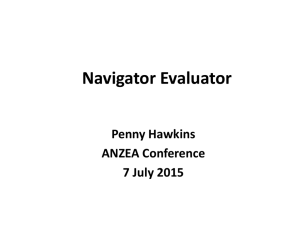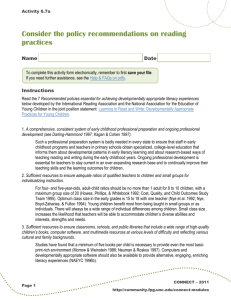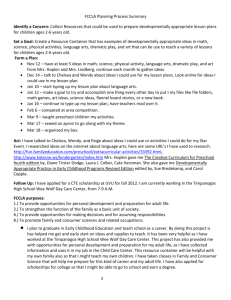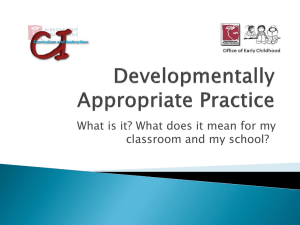Early Childhood Education
advertisement
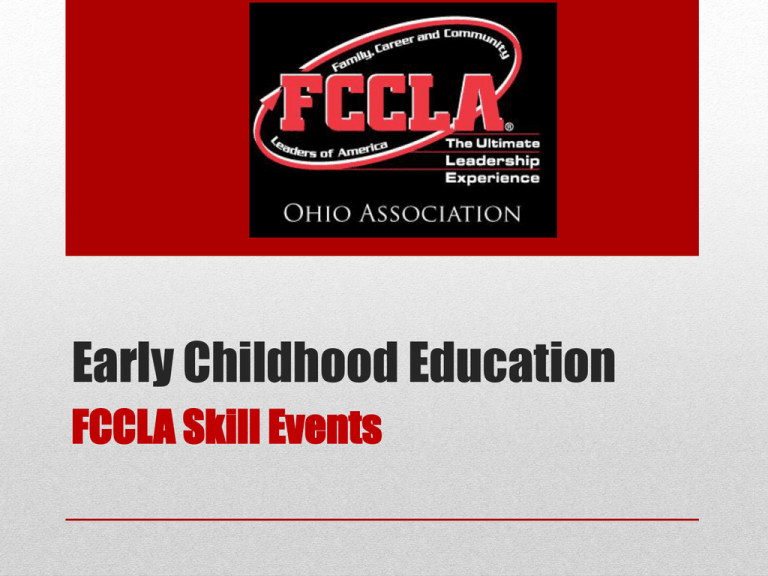
Early Childhood Education FCCLA Skill Events • To align with Education and Training Standards • To align with Early Learning and Development Standards Purpose of Updates Mary DeVault, Upper Valley Carol Fuller, Delaware Area Megan Grimm, Coshocton Natalie Heath, Upper Valley Renee’ Kluding, EHOVE Deb McDonald, Wayne County Marsha Osega, Vantage Kelly Marquis, Tolles ODE and FCCLA CONSULTANTS Mary Jo Kohl Paulette Farago ECE Skill Event Task Force o • Education and Training Field Career Technical Standards O • Ohio’s Early Learning and Development Standards W • Working with Young Children • Written by Judy Herr Resources • Can be used as a summative assessment for an SLO • Broad enough to represent the overarching standards • Narrow enough to be measured Education and Training Standards Early Learning and Development Standards ELDS Early Learning and Development Standards | Ohio Department of Education Social/Emotional Development Approaches Towards Learning Physical Well-Being and Motor Development Cognitive Development and General Knowledge Language and Literacy Development ELDS DOMAINS Language and Literacy Development Curriculum Unit Development Teacher Resource Assessment Kit Skill Event Names Early Childhood Team Event Consistency of layout Consistency of procedures Consistency of language and terms Consistency of presentations Clarity of Event Overview of Revisions CONSISTENCY OF LAYOUT CONSISTENCY OF LANGUAGE AND TERMS DEFINITIONS OF EARLY LEARNING AND DEVELOPMENT STANDARDS Standard statement Domain Curriculum Areas Learning Experiences Learning Objective Definitions from WWYC • Physical • Emotional • Intellectual or • Cognitive AREAS of Development PIES • Social Areas of Development CONSISTENCY OF PROCEDURES Description of Event • • • • Integration of Standards: Using lesson plan as a reference, if needed, explain how the extension activity is integrated with the chosen standard statements. Areas of Development: Explain how the story and/or the extension activities addresses children’s growth in at least three of the following areas: cognitive, intellectual, emotional and social. Developmentally Appropriate: Explain how the story and/or the extension activities address preschool children’s attention span and interest, meets the developmental level of the children and allows children to express creativity. Adaptations or Accommodations: Identify a disability/differing need then explain one way that one activity could be adapted to meet the needs of a child with that disability or differing need. Rating Sheet Needs Improveme nt Fair (Needs improve -ment) Good Excellent (clearly met) Integration of Standard 0 1 Statements: Explains how the standard statements are incorporated into the Story and Extension Activity Areas of Development: 0 1 Explains how the activities address at least three areas of development: cognitive, physical, emotional or social. 2 3 4 5 2 3 4 5 Developmentally 0 1 Appropriate: Explains how the activities address attention span and interest, meets the developmental level of the children and allows the children to be creative Adaptation or 0 1 Accommodation: Identifies one differing need and explains one adaptation or accommodation 2 3 4 5 2 3 4 5 DEVELOPMENTALLY APPROPRIATE PRACTICES Total Points: 20 Poor (Could not answer) (participant may use lesson plans for reference) Alignment of Description of Event to Rating Sheet ONLY THE PARTICIPANT’S EXPLANATION OF DEVELOPMENTALLY APPROPRIATE PRACTICE SHOULD BE SCORED IN THIS SECTION CONSISTENCY OF PRESENTATIONS Procedures for Language and Literacy Development Procedures for Curriculum Unit Development Plan an oral presentation of your story and extension activity. • Present each evaluator with a copy of the lesson plans in a folder or binder • Set up materials for story presentation and extension activity while evaluators review lesson plan. • Introduce self and school. • Identify story name and author. • Integration of Standards: Using lesson plan as a reference, if needed, explain how the story is integrated with the chosen standard statement. • Present the Story Lesson Plan to evaluators by involving them in the same way you would involve children. Story lesson plan demonstration must include motivation/opening, presentation of the activity and using the closing and transition. • Present the Extension Activity Lesson Plan to evaluators. Identify the Title of the Extension Activity. Explain or demonstrate the extension activity following the motivation/opening and procedures listed on plan. Involving the evaluators in the extension activity presentation is at the participant’s discretion. • Integration of Standards: Using lesson plan as a reference, if needed, explain how the extension activity is integrated with the chosen standard statements. • Areas of Development: Explain how the story and/or the extension activities addresses children’s growth in at least three of the following areas: cognitive, intellectual, emotional and social. • Developmentally Appropriate: Explain how the story and/or the extension activities address preschool children’s attention span and interest, meets the developmental level of the children and allows children to express creativity. • Adaptations or Accommodations: Identify a disability/differing need then explain one way that one activity could be adapted to meet the needs of a child with that disability or differing need. • Answer evaluator’s questions completely and concisely at the conclusion of the presentation. Plan an oral presentation to explain and discuss the development and utilization of the concept curriculum unit with children. • Greet evaluators. • Present folders to evaluators to review. • Set up display while evaluators review unit plan. • Introduce self and thematic unit. • Describe each learning experience by identifying its’ domain, curriculum area, title and standard statement by referring to your unit plan and display board. • Integration of Theme: Explain how the learning experiences helped children learn theme-related concepts. • Participation and Response: Describe the children’s participation and response to each learning experience. • Participant may interact with or demonstrate with materials from the display. Visuals or props used during the oral presentation must be returned within the dimensions of the display after handling. • Areas of Development: Explain how the learning experiences show developmental growth by telling evaluators how each learning experience addresses children’s growth in at least one of the following areas: physical, cognitive, emotional, and social. • Developmentally Appropriate: Explain one way one activity is developmentally appropriate for preschool children’s attention span and interest; • meets the developmental level of preschool children; and allows children to express creativity. (These can be met through one to three activities.) • Adaptation and accommodation: Identify a disability/differing need then explain one way one activity could be adapted to meet children’s special needs or individual differences. • Answer evaluator’s questions completely and concisely at the conclusion of the presentation. • Clean up materials while evaluators complete the score sheets. CLARITY OF EVENTS Rating Sheets Summary Sheet Rating Sheets – 4 pages Fillable forms Language and Literacy Development New Rules and Procedures for Language and Literacy Curriculum Unit Development New Rules and Procedures for Curriculum Unit Teacher Resource Assessment Kit NEW RULES AND PROCEDURES FOR TEACHER RESOURCE ASSESSMENT KIT Early Childhood Team Event NEW RULES AND PROCEDURES FOR EARLY CHILDHOOD TEAM EVENT EVENT Language Curriculum Teacher and Literacy Unit Resource Development Development Assessment Kit Early Childhood Team Event 1st Tie Breaker Story & Extension Demo -20 Explanation of Learning Activities DAP - 30 Demo and Data Analysis -35 Explanation of Preschool Day -30 2nd Tie Breaker Presentation Skills - 25 Presentation Skills- 30 Presentation Skills- 25 Presentation Skills – 20 3rd Tie Breaker Visuals and DAP 35 Display – 20 Assessment Kit, Materials and Instruments -20 Graphic Org. Block Plan -20 4th Tie Breaker Lesson Plan-20 Unit Plan -20 Assessment Plan 20 Case Studies -20 Scores and Tie Breakers Chairperson is the procedure expert Evaluator is the content expert Chairperson Responsibilities Consistent and Fair evaluation of student work Chairperson Instructions Highlight these points: Score sheets are divided in four sections. Make sure the points taken off correlate to the indicators in that section. Avoid taking off points off in two areas for the same error/mistake. If students do not offer information that is required, ask them a question to get the answer. Score accordingly. Accommodations and Adaptations should relate to the special need the student identified. Students do not need to know accommodations for all areas of special needs Keep event within required time limits. Stop presentations as required. if student did not finish required presentation points in time allowed, ask questions to allow explanation of points not covered. Score accordingly (example: instead of full points, give points for “answered with prompt”. Perfect scores should not be given to reduce the need to break a tied score. All presenters should have something to improve upon. However, in the case of outstanding performances, one or two judges may give perfect scores to keep the presenter’s average at a high level.
